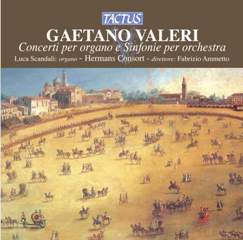Gaetano Valeri - Concerti per organo e Sinfonie per orchestra (2012)
Gaetano Valeri - Concerti per organo e Sinfonie per orchestra (2012)

Fabrizio Ammetto: Sinfonia in D major 9:24 1.I. Allegro con brio 4:25 2.II. Largo - Allegro con brio 4:59 Gaetano Valeri: Organ Concerto in G major 14:50 3.I. Allegro 6:17 4.II. Largo 3:35 5.III. Rondo: Allegro 4:58 6.Gaetano Valeri: Sinfonia rondo in C major 3:34 7.Gaetano Valeri: Sinfonia in D major-B minor 5:06 8.Gaetano Valeri: Sinfonia in B flat major 4:28 Gaetano Valeri: Organ Concerto in B flat major 12:58 9.I. Allegro moderato 5:42 10.II. Adagio 2:45 11.III. Rondo: Allegro 4:31 Gaetano Valeri: Sinfonia in D major 10:16 12.I. Allegro 4:51 13.II. Larghetto - Allegro 5:25 Luca Scandali - organ Hermans Consort (Terni) Fabrizio Ammetto - concertmaster & director
A little-known aspect of Gaetano Valeri’s musical production, and one still to be studied, is represented by his Sinfonie, the parts of which are extant in manuscript in the Biblioteca Capitolare of Padua (cat. nrs. 59. 21, 28-33) and in the Biblioteca Civica of Lugo di Romagna (C 13). Gaetano Valeri uses the term “sinfonia” to indicate his instrumental compositions (for strings and two pairs of winds) written in a single movement, or occasionally in two movements (Allegro and Largo) with a repetition of the first, utilizing the form which he most favored in his keyboard sonatas. The option of a single movement was characteristic of composers from the Veneto (the most significant representative being B. Galuppi), and it continued to be a favorite form of Paduan composers even at the end of the eighteenth century. In the case of the bipartite works, Valeri juxtaposes episodes contrasting in both character and tempo, following the example of B. Marcello and, again, Galuppi. The repetition of the fast first movement, on the other hand, reflects a formal structure employed by P. Anfossi in the “da capo” ouverture. Like the sonatas, Valeri’s Sinfonie commonly present a division into two parts, recalling the dance forms of the baroque suite. The subdivision is unrelated to the thematic organization since each part is in turn divided into two sections within which the thematic material is distributed, preferably following a pattern of ABAB. The themes are played twice, separated by secondary elements of a virtuosic character. The treatment does not yet foresee the classical sonata form of exposition-development-recapitulation; instead, we still find a series of motifs of contrasting character linked by melodic passages, following the teachings of G.B. Sammartini. Although not unaware of the innovations of classicism, Gaetano Valeri apparently chose to hang on to stylistic elements typical of the stile galante, preferring the simplification of compositional form which favors the relationship between melody and accompaniment. ---tactus.it
The name of Gaetano Valeri is one that makes even experts in the field of classical music history go "What?" Valeri was a provincial Italian musician who assumed the post of maestro di capilla at Padua Cathedral at the age of 25 in 1785 and held it until his death at 61 in 1822. Valeri had only a glancing brush with the theater, contributing to a pasticcio or two, and his output, concentrated at the Archivo Capitolare della Curia Vescovile in Padua but in part scattered throughout Italy, is overwhelmingly vocal and intended for church use. His works for solo keyboard began to attract some interest in the last decade of the twentieth century, largely thanks to work on Valeri's behalf by Italian musicologist Giuseppe Radole. Tactus' Gaetano Valeri: Concerto per organo e Sinfonie per orchestra presents us a banquet we didn't know we had, five of Valeri's symphonies and two organ concerti. Will we come to the table?
The symphonies, performed by the Hermans Consort under Fabrizio Ammetto, range from being highly enjoyable to just okay; Valeri was a rather conservative symphonist of the late eighteenth century as these one- and two-movement works combine the mid-century formal schemes of Giovanni Sammartini with stylistic gestures familiar from the Viennese school of Mozart and Haydn. The most interesting of them is the latest, the Sinfonia in D major/B minor of 1816, not only owing to its odd key relationship but also to a palpable sense of excitement in the F sharp minor movement rather reminiscent of Rossini. The organ concertos, with the solo part played by Luca Scandali, are a great deal more interesting than the symphonies, and that is partly due to the extraordinary-sounding period instrument on which they are played, a 1792 Gaetano Callido organ at the church of S. Esuperanzio in Cingoli, rebuilt in 2003. It is at turns reedy, whistle-y and nasal sounding, yet there's a big Baroque stop that Scandali uses rather sparingly. The organ is heard best in the G major Concerto, where it is placed upfront and personal in the recording; in the B flat Concerto the signal from the organ is a little weaker for some reason; also, the G major Concerto is a slightly more imaginative piece.
The Hermans Consort performs with a great deal of enthusiasm and energy throughout the disc, though a little reining in would have been welcome, as the orchestral playing is rough and a little sloppy at times. Organ fanciers should certainly hear this instrument -- it sounds like a medieval carousel organ gone mad. While as a composer Valeri is creditable, the welcome rediscovery of his work is tempered somewhat by its quality, as it hardly poses a threat to Valeri's more illustrious contemporaries, namely Mozart and Cherubini. ---Uncle Dave Lewis, AllMusic Review
download (mp3 @320 kbs):
Last Updated (Friday, 28 September 2018 14:18)








